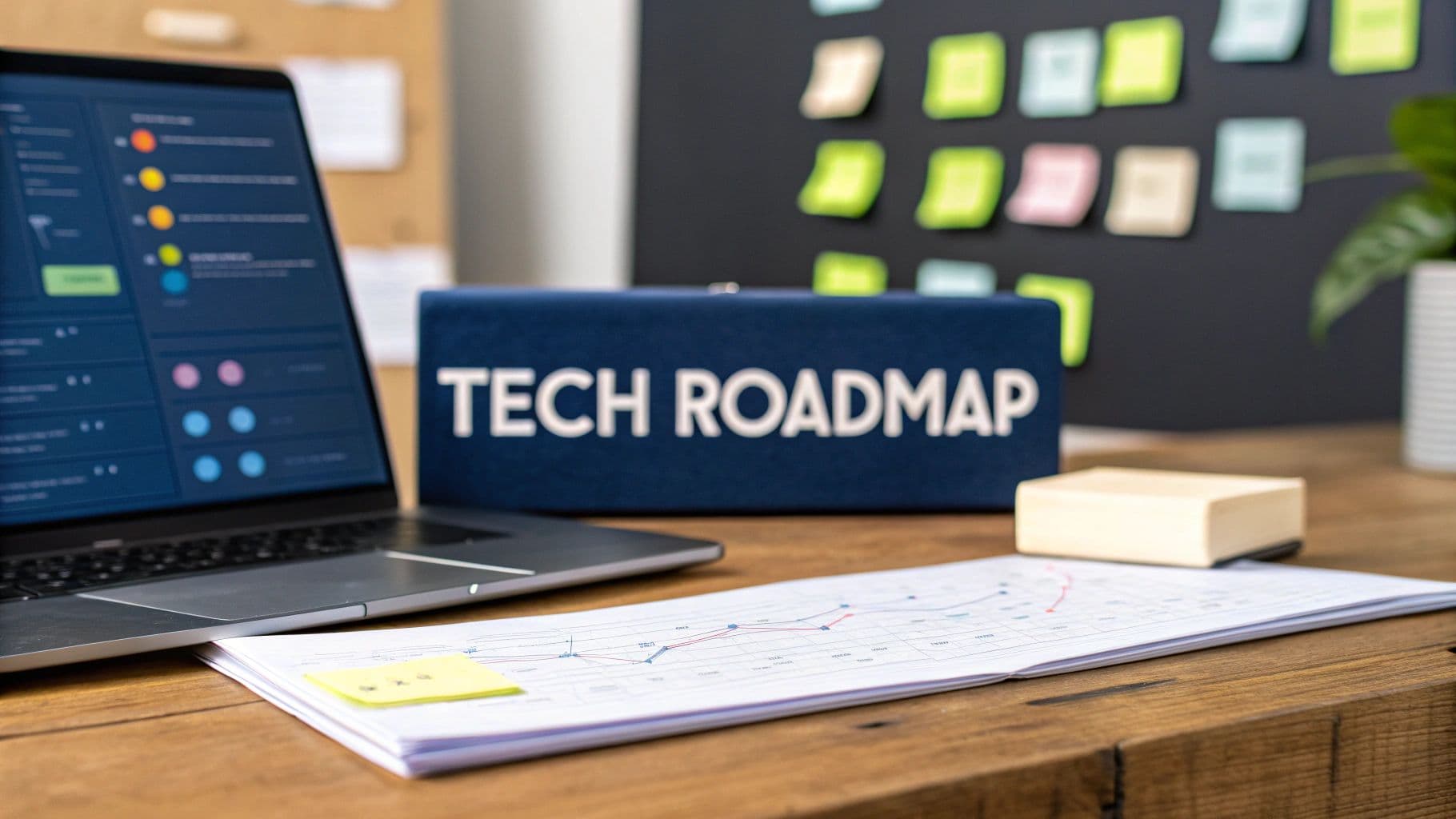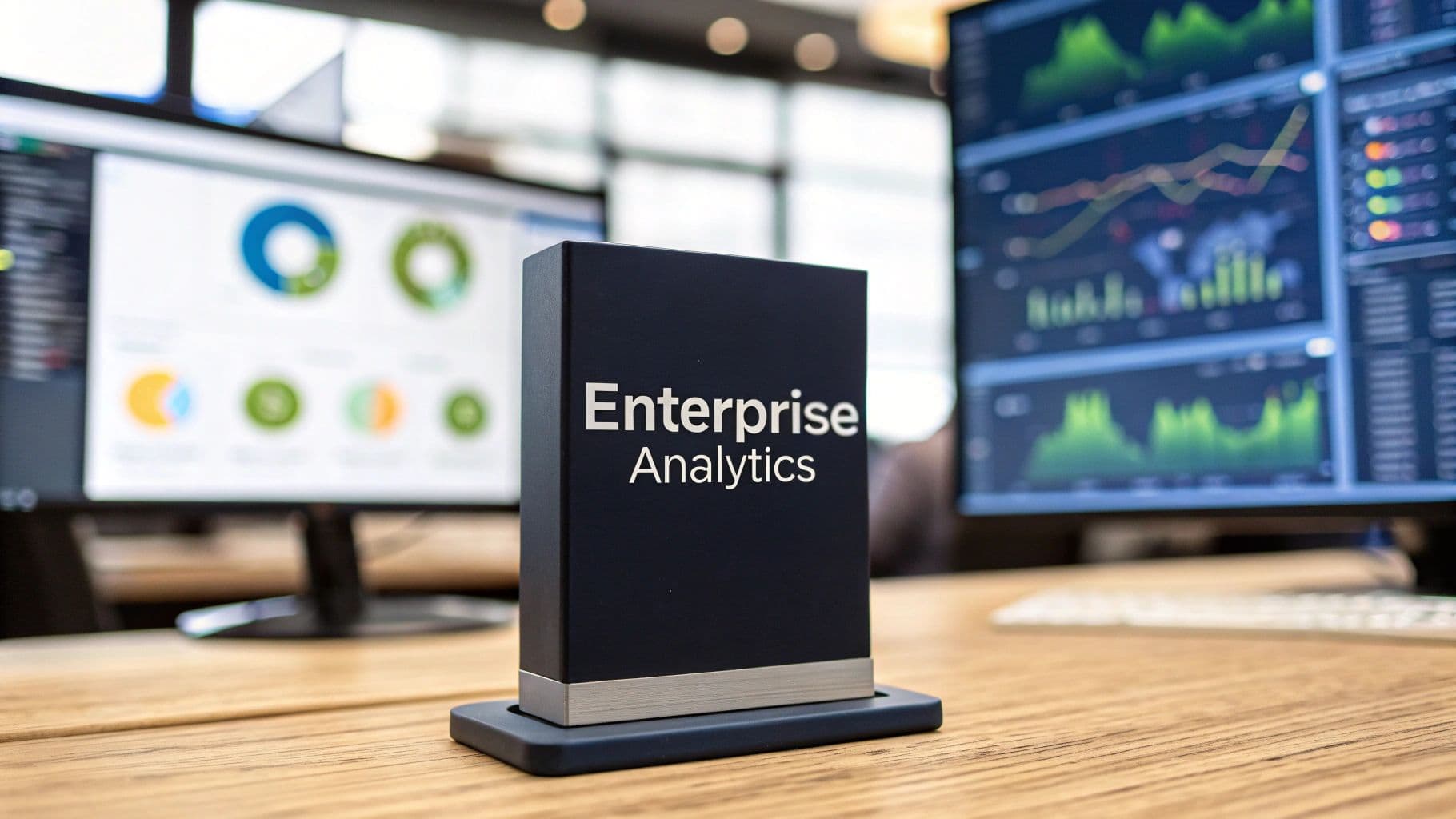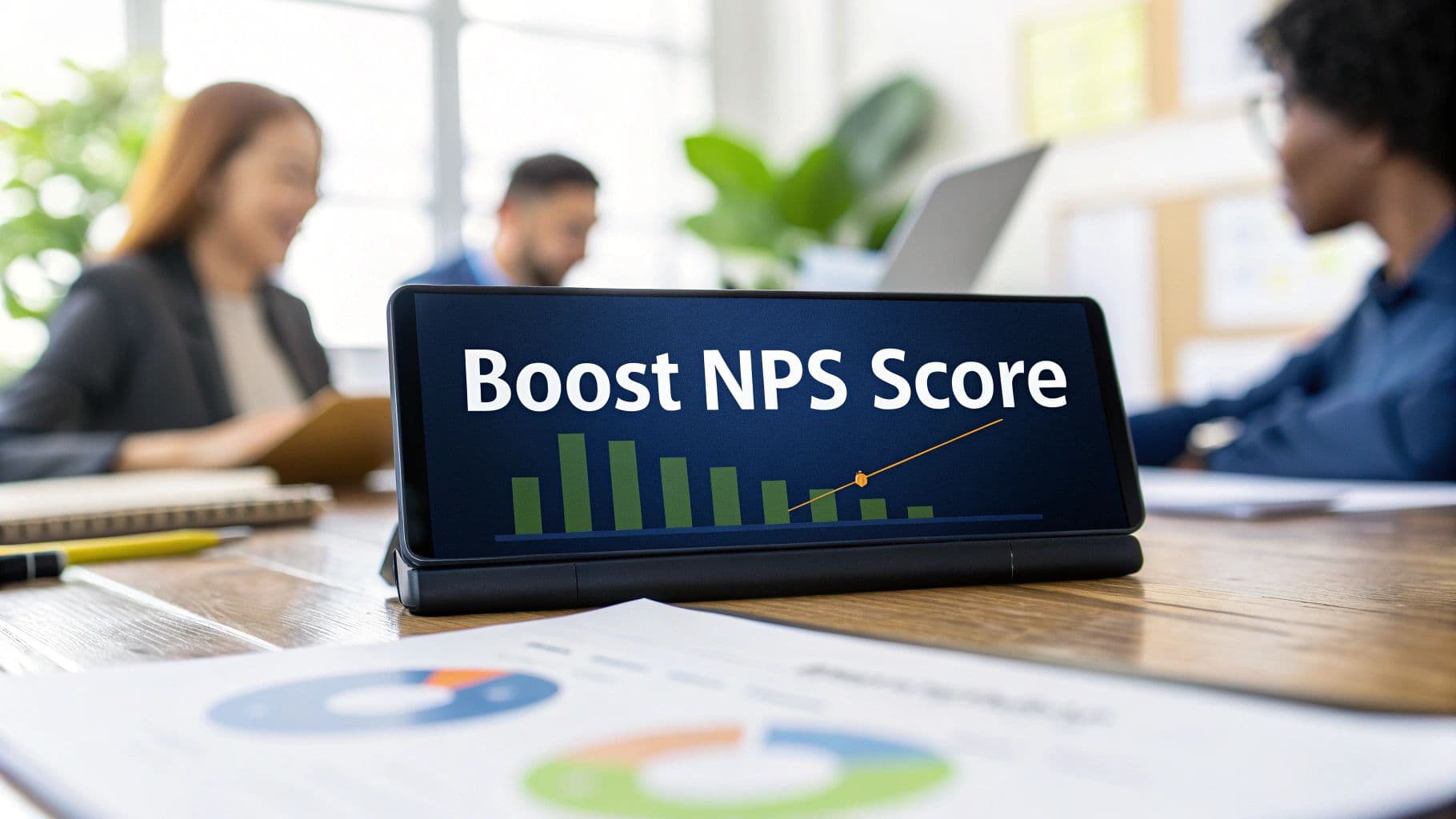What is Continuous Monitoring? Essential Guide to Protect Your Business
Learn what is continuous monitoring, how it safeguards modern businesses, and effective strategies for implementation. Discover its benefits today!
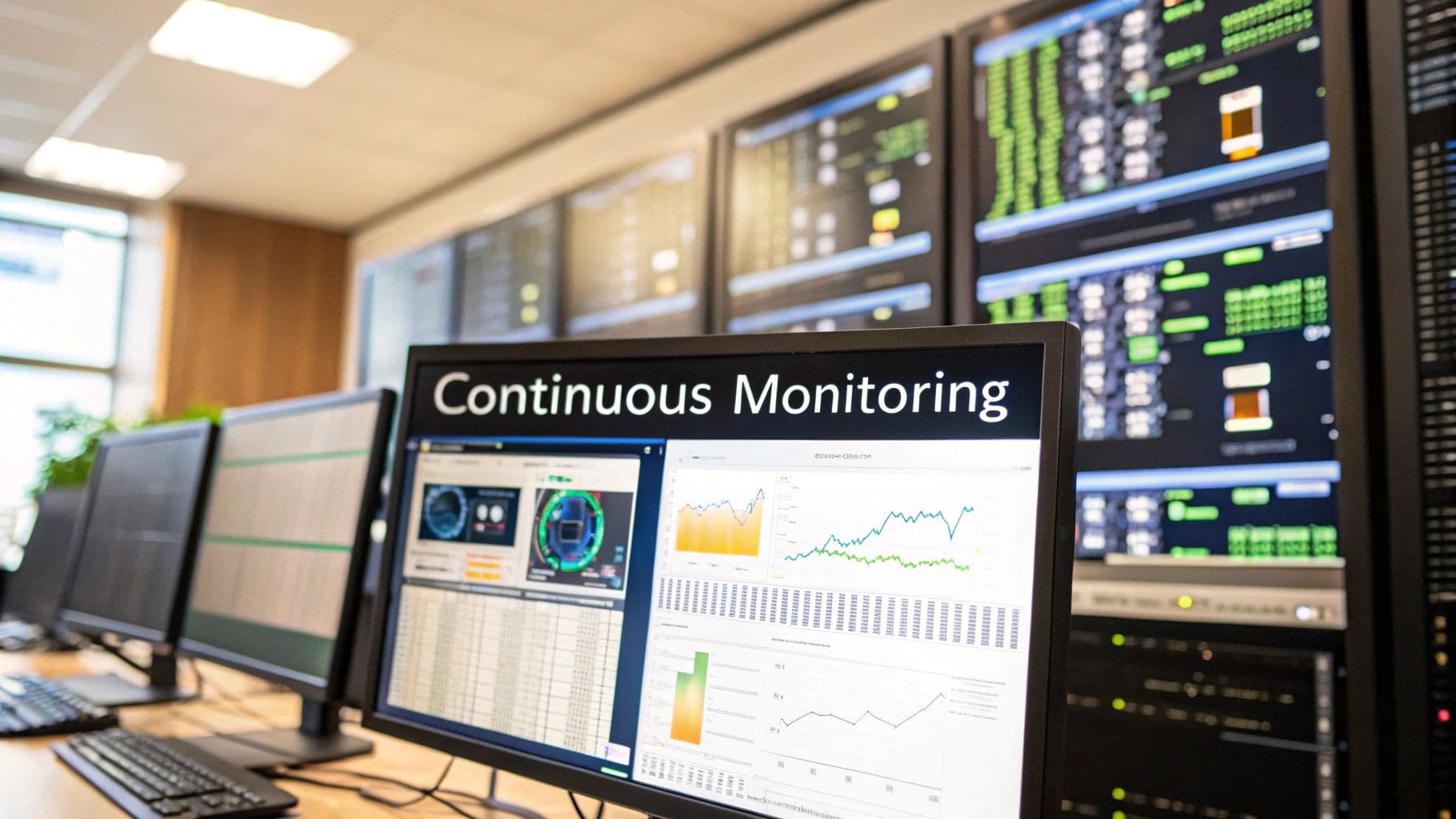
So, what exactly is continuous monitoring? Think of it as a living, breathing part of your digital environment. It's the process of automatically and constantly keeping an eye on everything—your networks, applications, and data—to spot security threats, performance hiccups, or compliance gaps the second they appear.
This isn't your old-school, once-in-a-while manual check. It’s an always-on, 24/7 automated watch that gives you a real-time view of what’s happening across your entire system.
What Is Continuous Monitoring in Simple Terms
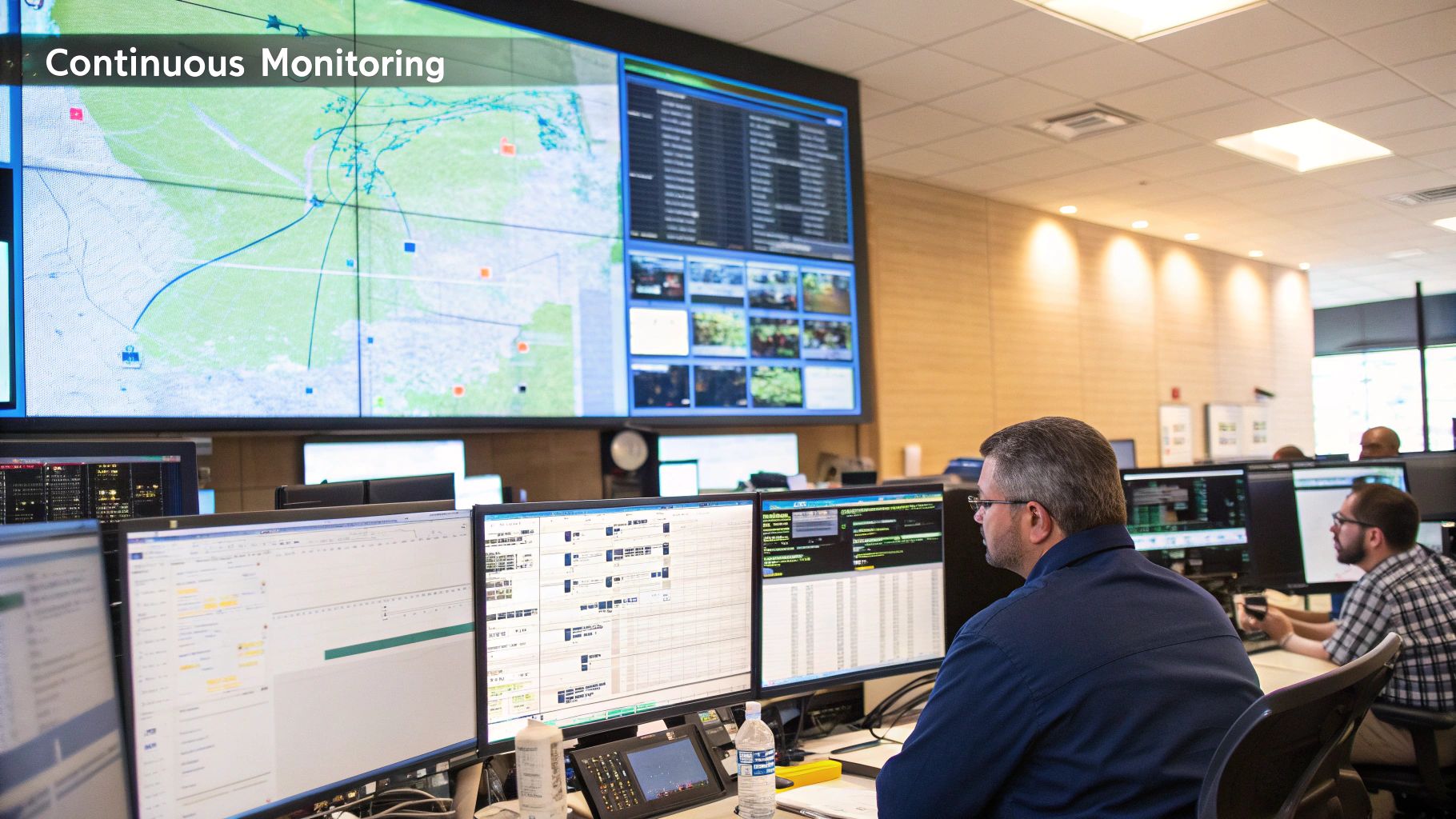
Let’s try a simple analogy. Imagine your company’s infrastructure is a massive, bustling warehouse. Traditional monitoring is like sending a security guard to walk the floor once every few hours. They might eventually find a leaky pipe or an unlocked door, but by then, the damage could already be done. It’s a reactive and slow-moving process.
Now, what is continuous monitoring? It’s like outfitting that same warehouse with a high-tech security system. We're talking cameras in every aisle, motion sensors on every door, and alarms that feed directly into a central command center. This system never sleeps, never blinks, and never misses a thing. It sees everything, all the time.
A Proactive Approach to Risk Management
This modern approach isn't just about a single tool; it's a complete strategy built for constant awareness. It automates the collection, analysis, and response to data from your entire IT environment in real time. Unlike older methods that relied on scheduled, manual checks, continuous monitoring uses sophisticated systems to perpetually watch for security threats and performance issues. You can find more expert takes on this IT practice over on Splunk.com.
This proactive mindset completely changes the conversation. You stop asking, "What happened?" and start asking, "What is happening right now?" For modern IT, security, and DevOps teams, that real-time insight is a game-changer. It means you can:
- Identify threats instantly: Spot unusual activity the moment it occurs, not hours or days later.
- Ensure compliance: Maintain a live, ongoing view of your adherence to regulations like GDPR or HIPAA.
- Maintain performance: Catch system slowdowns or errors long before they ever affect your customers.
Let's break down how this modern approach stacks up against the old way of doing things.
Continuous Monitoring vs Traditional Monitoring at a Glance
The table below paints a clear picture of why the shift to continuous monitoring is so essential for any modern business. It highlights the fundamental differences in speed, scope, and overall effectiveness.
| Aspect | Continuous Monitoring | Traditional Monitoring |
|---|---|---|
| Frequency | Real-time, 24/7 | Periodic, scheduled (e.g., daily, weekly) |
| Approach | Proactive | Reactive |
| Data Collection | Automated and constant | Manual or scheduled batch jobs |
| Response Time | Immediate (minutes or seconds) | Delayed (hours or days) |
| Visibility | Comprehensive and always-on | Snapshot-in-time, limited scope |
| Risk Detection | Catches emerging threats instantly | Discovers issues after they've occurred |
As you can see, the two methods are worlds apart. One is designed for today's fast-paced, complex environments, while the other was built for a simpler, slower time.
Ultimately, continuous monitoring isn't just a "nice to have" anymore; it's a non-negotiable standard. It delivers the speed and visibility needed to protect complex digital operations. It's the difference between reacting to yesterday’s problems and proactively managing today’s risks.
Why Continuous Monitoring Is Essential Today

The push for constant vigilance isn't just another industry trend; it's a necessary reaction to how drastically the business world has changed. Think back not too long ago, when a company's digital presence was fairly self-contained, almost like a small town with clearly marked borders. Security teams could walk the perimeter, check the locks at night, and feel pretty confident that things were secure.
That quiet town has since exploded into a sprawling, hyper-connected metropolis. Today’s digital environment is a tangled web of cloud servers, microservices, remote employee devices, and countless third-party APIs. This expansion creates a massive and constantly shifting attack surface, leaving thousands of new doors and windows that the old "once-a-day" security check simply can't cover.
Threats Have Gotten Smarter
This new, complex landscape hasn't gone unnoticed by those with bad intentions. Cyberattacks have evolved from clumsy smash-and-grab jobs into sophisticated, stealthy campaigns. Attackers now deploy automated tools, and even AI, to constantly probe for weaknesses, move silently within a network, and bide their time until the perfect moment to strike.
Relying on periodic or scheduled monitoring in this new reality is like checking for burglars only once a day. It leaves huge, dangerous gaps where threats can slip in and cause catastrophic damage long before anyone is the wiser.
This constant oversight is so critical because threats are no longer static. Modern SaaS companies face everything from quiet malware designed to slowly siphon data over months to coordinated ransomware attacks that can halt your entire operation in a matter of minutes.
Moving From a Moat to a Watchtower
As organizations grapple with more frequent and complex cyber threats across their distributed systems, the need for continuous monitoring becomes undeniable. Keeping a constant eye on networks, applications, and infrastructure is no longer just a good idea—it’s a necessity that far surpasses traditional batch monitoring, which leaves dangerous windows of opportunity for attackers. You can find more insights on this shift over at TrendMicro.com.
This evolution from a static defense—like a castle moat—to active, real-time awareness is the cornerstone of modern security and operational resilience. It’s what allows teams to:
- Protect Sensitive Data: With constant oversight, you can spot unauthorized access or unusual data movement the moment it happens, safeguarding customer information and your own intellectual property.
- Maintain Operational Uptime: Performance bottlenecks or system failures get flagged and fixed before they ever affect your users, ensuring your service stays online and reliable.
- Build Customer Trust: When you can demonstrate a proactive, vigilant commitment to security and stability, it strengthens your reputation and gives customers the confidence they need to rely on your platform.
At the end of the day, the question isn't if an organization will face a security incident, but when. The speed and clarity of your response will determine the outcome. Without the always-on visibility that continuous monitoring provides, your team is essentially fighting in the dark. It's an unfair fight, and one that modern businesses simply can't afford to risk.
Understanding the Three Pillars of Monitoring
To really get what continuous monitoring is all about, we need to move past the buzzwords and look at how it actually works. At its core, the whole process rests on three key pillars that form a constant loop: Visibility, Analysis, and Response. Thinking about it this way gives you a simple, memorable framework for understanding the entire system.
It helps to think of it like a modern home security system. You have the cameras and sensors watching every corner (that's Visibility). Then you have the central hub that processes the video feeds, looking for anything out of the ordinary (that's Analysis). Finally, you have the automated alarm and the instant notification to your phone (that's the Response). Each part is absolutely essential.
This image breaks down how these pieces fit together.
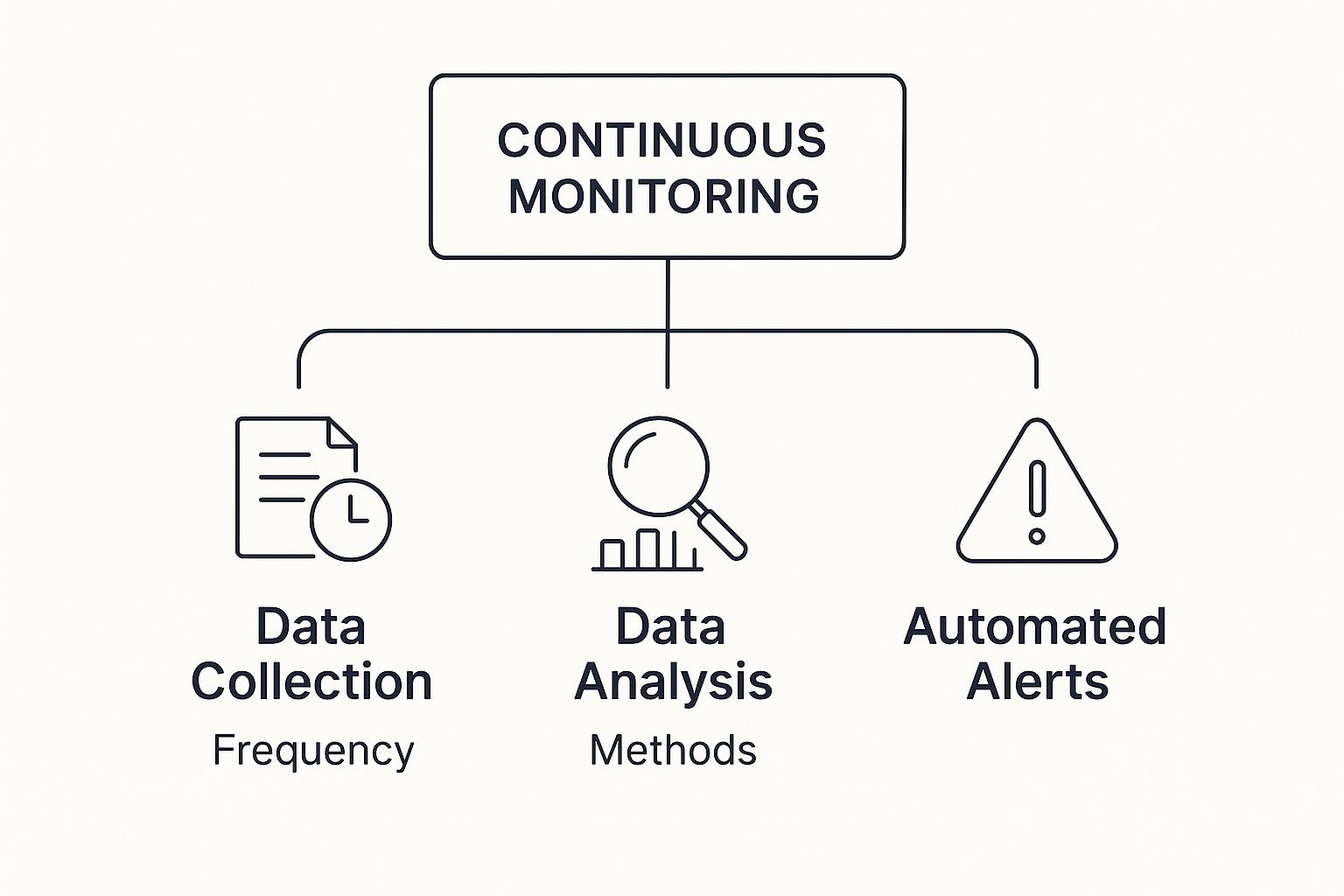
As you can see, it all starts with collecting data, which then gets analyzed, leading to automated alerts. This is the fundamental flow that keeps the whole system running.
Pillar 1: Visibility and Data Collection
First up is Visibility, and it's the most important one. You simply can't protect what you can't see. This pillar is all about gathering a constant, comprehensive stream of data from every nook and cranny of your IT environment. This is the raw intelligence that fuels the whole monitoring engine.
And we're not just talking about one type of data. True visibility means pulling from dozens of sources at once to build a rich, multi-layered picture of your operations, leaving no blind spots.
Key data sources typically include:
- System Logs: The event records generated by your operating systems, services, and applications.
- Network Traffic: All the data packets flowing across your internal and external networks.
- User Activity: Things like login attempts, file access records, and changes to permissions.
- Application Performance Metrics: Key indicators like response times, error rates, and resource usage.
- Cloud Configurations: Any settings and changes happening within your cloud infrastructure.
By pulling all this together, you start to build a complete, real-time map of your environment's health and security posture.
Pillar 2: Real-Time Analysis and Detection
Once you have this flood of data coming in, the second pillar—Analysis—kicks in. This is where the real magic happens. Let's be honest, no human team could ever sift through millions of data points every second. That's why modern continuous monitoring relies so heavily on automation, machine learning (ML), and artificial intelligence (AI).
Think of these automated systems as tireless digital detectives. They're trained to learn what "normal" looks like for your specific environment. This baseline of normal behavior is the key, because it allows the system to spot even the slightest deviations that could signal a problem.
For example, an AI might flag an employee account that suddenly starts accessing files at 3 AM from an unusual location. This isn't a known virus, but that anomalous behavior is a huge red flag that a person would almost certainly miss in a sea of log files. That’s the power of intelligent, real-time analysis.
Pillar 3: Automated Response and Remediation
The final pillar is Response. Gaining visibility and analyzing data doesn't mean much if you don't act on what you find. This pillar is all about taking immediate, decisive action the moment a threat or issue is spotted. In a world where attacks can unfold in minutes, speed is everything.
Automation is your best friend here. While some alerts will always need a human to make the final call, many of the initial response actions can—and should—be automated to contain threats instantly.
Common automated responses include:
- Alerting Security Teams: Instantly pinging the right people via email, Slack, or other platforms with all the details of the incident.
- Isolating a Compromised Device: Automatically quarantining an infected laptop or server from the network to stop a threat from spreading.
- Blocking Malicious Activity: Updating firewall rules in real-time or blocking IP addresses tied to an attack.
Together, these three pillars form a powerful, self-reinforcing cycle. Constant visibility feeds intelligent analysis, which triggers a swift response. This loop creates a robust and proactive defense for your entire digital ecosystem.
Extending Monitoring Beyond Security to Compliance
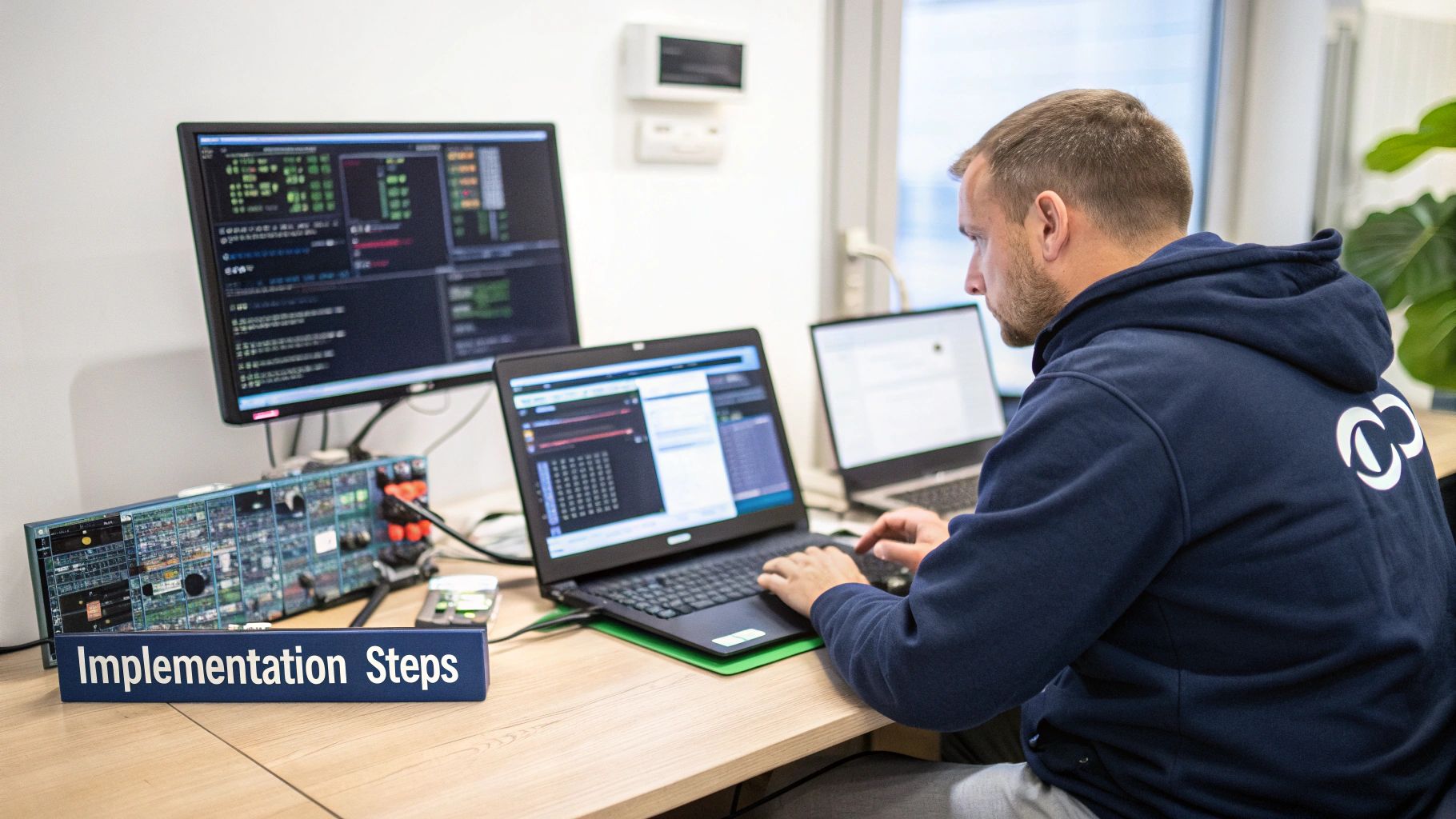
While most people think of continuous monitoring as a security tool, its power goes far beyond just catching threats. It’s also an indispensable ally for navigating the complicated, ever-shifting world of regulatory compliance.
For any company that handles sensitive information, staying on top of standards like GDPR, HIPAA, and PCI DSS isn't just good practice—it's a legal requirement. Continuous monitoring gives you the tools to prove you're following the rules, turning compliance from a constant source of anxiety into a manageable, everyday process.
From Painful Audits to Perpetual Readiness
Think about the traditional approach to compliance. It usually involves frantic, point-in-time audits. This is a lot like cramming for a final exam—a stressful, last-minute push to get everything in order, followed by a long period of just hoping nothing goes wrong before the next one. It’s inefficient and leaves huge gaps where your company could fall out of compliance without anyone noticing.
Continuous monitoring completely flips that model. Instead of looking at occasional snapshots, it provides a live, dynamic view of your compliance posture. You go from hoping you're compliant to knowing you are, at any given moment.
This proactive approach does wonders for building trust with customers and partners. It’s a clear, verifiable signal that you're committed to protecting their data and managing risk, which can be a real competitive advantage.
How Continuous Monitoring Simplifies Compliance
A continuous monitoring framework is designed to systematically check your systems against the specific controls required by different regulations. This ongoing assessment is rapidly replacing old-school audits for a reason: it provides a much more accurate picture of an organization's risk and compliance status. As new regulations emerge to cover complex supply chains, this constant oversight is becoming even more critical. The team at SecurityScorecard offers a great analysis of this industry-wide shift.
Here’s what this looks like in the real world:
- GDPR: A monitoring system can track where data from EU citizens is stored and who accesses it. It logs every processing activity, helping you meet strict data residency and access control rules.
- HIPAA: The system can constantly verify that controls for Protected Health Information (PHI) are correctly configured. If an unauthorized user tries to access patient records, it generates an immediate alert.
- PCI DSS: It can automatically scan for vulnerabilities in your cardholder data environment, check firewall rules, and ensure encryption standards are always applied to protect payment information.
This level of automation drastically reduces the manual workload that traditionally bogs down compliance and security teams.
Integrating Compliance with Business Intelligence
The data you gather from a continuous monitoring program isn't just for auditors. When you analyze it the right way, it can reveal valuable insights that shape your broader business strategy. For example, understanding data access patterns might help you optimize a workflow or boost operational efficiency.
By connecting compliance data with other business metrics, you start to see the bigger picture. This approach is a key part of building a strong enterprise data analytics strategy, where insights from across the company drive smarter decisions.
Ultimately, continuous monitoring bridges the gap between your security operations and your compliance obligations. It automates the tedious work of gathering evidence, gives you real-time assurance that you're meeting regulatory duties, and transforms compliance from a periodic headache into a seamless part of your business. This frees up your teams to focus less on audit prep and more on what really matters: innovation and growth.
How to Implement a Continuous Monitoring Strategy
Alright, you understand what continuous monitoring is. Now for the hard part: how do you actually build it? Let's be clear—this isn't about buying a fancy new tool and calling it a day. A real strategy is a roadmap. It’s about being deliberate, defining your goals, picking the right tech, and getting your team ready.
If you follow a clear plan, you won't just be collecting data for the sake of it. You'll build a system that works and lasts.
First, Figure Out What You’re Trying to Do
Before you monitor a single thing, you need to know what "good" even looks like for your business. Start by identifying your crown jewels—the critical systems, apps, and data that you absolutely cannot afford to lose.
Once you know what’s most important, you can set real, measurable goals. These objectives will become your North Star for every decision that follows, from the tools you buy to how you handle an incident.
Think about goals like these:
- Slash Detection Time: Aim to spot security threats in minutes, not hours.
- Guarantee Uptime: Set a hard target, like 99.9% uptime, for your core applications.
- Automate Compliance Headaches: Cut the manual work for audits like GDPR or HIPAA by 75%.
- Focus on What Matters: Create a system that prioritizes alerts by business impact, so your team isn't just chasing noise.
With these goals defined, you’re ready to look at the technology.
Choose the Right Tools for the Job
The market is flooded with monitoring tools, but the "best" one is simply the one that fits your world. Don't get distracted by shiny new features. Your top priority should be finding a solution that plugs into your existing tech stack, whether you're fully in the cloud, on-prem, or somewhere in between.
Look for a platform that can pull in data from everywhere you need it to—system logs, network traffic, user activity, and application performance metrics. The real magic happens when you can bring all that disparate information into one unified view. That's what separates a true monitoring platform from a basic alerting tool.
Even better, look for platforms with smart analytics baked in. A modern monitoring system should learn what "normal" looks like in your environment so it can immediately flag when something’s off. If you want to see how this works, you can explore how to analyze user behavior with SigOS to uncover critical patterns and drive product intelligence.
Have a Plan for When Things Go Wrong
Great tech is only half the battle. What happens when your shiny new system actually finds something? Your team needs to know exactly what to do, without hesitation. That’s where a solid incident response plan comes in.
This isn’t a vague document; it’s a step-by-step playbook that covers:
- Who Does What: Clearly define roles and responsibilities.
- Escalation Chains: Know when to bring in senior team members or leadership.
- Communication Lines: Have a plan for talking internally and with customers.
- Fix-It Steps: Pre-approve actions for containing and resolving common issues.
Writing this down eliminates the guesswork and panic during a real crisis. And don’t just write it down—practice it. Running regular drills ensures everyone is ready to act when it counts.
Best Practices to Keep the Strategy Working
Finally, remember that this is an ongoing process, not a one-and-done project. To keep your strategy sharp, you need to think in terms of continuous improvement.
- Start Small, Then Grow: Don't try to boil the ocean. Begin with your most critical assets and expand from there.
- Automate the Boring Stuff: Let machines handle repetitive tasks like data collection and initial alert filtering. This frees up your people for more important work, like analysis and threat hunting.
- Tune Out the Noise: Constantly refine your rules and alerts to reduce false positives. If your system cries wolf all the time, people will start ignoring it.
- Keep Your Team Sharp: Technology and threats change fast. Invest in ongoing training to make sure your team knows how to interpret the data and use your tools effectively.
By combining clear goals, the right technology, and a well-rehearsed team, you can build a continuous monitoring strategy that does more than just protect you—it becomes a source of powerful business and operational intelligence.
The Next Frontier Is Continuous Behavioral Analysis
Traditional continuous monitoring is fantastic for catching known problems and policy breaches, but it has a built-in blind spot: it mostly relies on rules you've already defined. What do you do when the real threat is something you've never even thought to look for? This is where the game changes, and continuous behavioral analysis steps in.
Think of it this way. Traditional monitoring is like a security guard with a checklist, making sure all the doors are locked. Continuous behavioral analysis is like a veteran detective who’s walked the same beat for years. They don't just check the locks; they notice the subtle rhythm of the neighborhood. They know when a light is on in an office that's usually dark, or when a delivery truck shows up at an odd hour. It's that deep, instinctual understanding that spots trouble before it happens.
Moving Beyond Rules to Baselines
Instead of just checking off boxes, continuous behavioral analysis uses AI to build a dynamic, ever-evolving picture of what "normal" looks like across your entire digital world. It learns the unique habits and patterns of every user, system, and application.
For example, it gets to know:
- Which databases a particular developer typically works with.
- The usual hours a member of the finance team is logged in.
- The normal amount of data a specific server sends out each day.
This intelligent baseline becomes the standard for what's right. Any meaningful drift from these learned behaviors immediately triggers an alert, even if no specific "rule" was broken. We take a much deeper look into this concept in our guide on what is behavioral analytics.
By focusing on context and behavior, this method can detect incredibly sophisticated threats that traditional systems often miss entirely. It’s not just about finding the needle in the haystack; it's about noticing when the haystack itself looks different.
This makes it incredibly powerful for spotting threats that are designed to fly under the radar, like:
- Insider Threats: An employee with valid credentials suddenly starts poking around in sensitive folders that have nothing to do with their job.
- Advanced Persistent Threats (APTs): A quiet attacker moves laterally through your network, making small moves to avoid detection and blend in with normal activity.
- Zero-Day Exploits: A brand-new attack is launched against your systems—one that has no known signature for old-school tools to find.
Connecting Security to Business Outcomes
But here's where it gets really interesting. The insights you gain from behavioral analysis aren't just for security. The very same data that highlights a risk can also shine a light on huge business opportunities and hidden operational problems. When you truly understand how people actually use your product, you’ve unlocked a whole new level of product intelligence.
Imagine seeing a sudden drop in engagement with a core feature. That's not just a number on a dashboard; it could be a sign of a critical performance bug or a confusing UI change that needs to be fixed right away. On the flip side, seeing a small group of power users quickly adopt a new feature can tell you exactly where your next big growth opportunity lies.
This approach elevates monitoring from a purely defensive task into a proactive engine for business growth. It creates a direct line between security operations and real-world results like lowering customer churn, boosting feature adoption, and fixing performance bottlenecks before they ever hurt your reputation. This isn't just about staying secure anymore—it's about staying ahead.
Frequently Asked Questions
Even after covering the basics, a few practical questions always pop up about what continuous monitoring looks like on the ground. Let's tackle some of the most common ones to clear up any confusion and help you move forward.
Is Continuous Monitoring Just for Big Companies?
Not anymore. While massive enterprises certainly paved the way, continuous monitoring is now a must-have for businesses of all shapes and sizes. Cyber threats don’t check your company’s headcount, and the operational perks—like better uptime and smoother performance—are valuable to everyone.
The rise of cloud-based tools has completely changed the game, making this level of security and insight accessible and affordable for startups and small businesses. At its core, this is all about managing risk, and every single business has risks. A data breach can torpedo a small startup's reputation just as easily as it can a Fortune 500 company's.
How Is This Different from Regular System Audits?
The biggest difference comes down to timing. Think of a traditional audit as a snapshot in time. It’s a great, detailed picture of your security and compliance posture on the day it was taken. But the second a new employee is hired or a new piece of code is deployed, that picture is already out of date.
Continuous monitoring, on the other hand, is like a live video feed of your entire environment. It gives you a dynamic, ongoing view, so you can spot and react to issues the moment they happen—not weeks or months later when the next audit rolls around.
It’s about shifting from a reactive, backward-looking review to proactive, real-time awareness. That’s the fundamental upgrade here.
What Are the Biggest Challenges in Implementation?
Getting a continuous monitoring strategy off the ground does have a few common speed bumps. The most notorious one is alert fatigue. If your system isn't tuned correctly, it can blast your team with a firehose of false alarms, and soon enough, they start ignoring everything—including the real threats.
A few other hurdles to watch out for:
- Integration Complexity: Stitching together dozens of different tools and data feeds from both old and new systems can feel like a nightmare without a central platform to pull it all together.
- Skill Gaps: You need people who can do more than just operate the tools. Your team has to be able to interpret the data, understand the context, and know how to respond when a serious alert comes through.
- Evolving Regulations: Compliance standards are always changing. Keeping your monitoring rules aligned with the latest requirements is a constant effort.
Overcoming these obstacles starts with a clear plan, choosing the right tools for your team, and committing to ongoing training and process improvement.
SigOS turns this constant stream of data into revenue-driving intelligence. By applying continuous behavioral analysis, our platform moves beyond simple alerts to identify the user actions that directly impact churn and expansion. Discover how to prioritize your roadmap based on real customer behavior. Learn more about our product intelligence platform.
